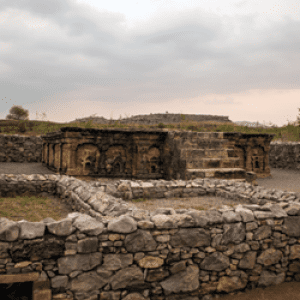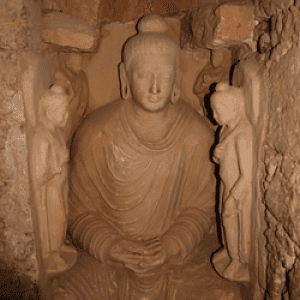7 days 6 nights
Daily Tour
Unlimited
English
Explore the traces of the Ancient Gandhara Civilization, a lively community dating back 2000 years ago. Due to its historical significance within the Buddhist Community, Taxila has declared a UNESCO world heritage site in 1980. The Guardian Newspaper announced Taxila as the top tourist destination in 2006. The tour involves various archeological sites of the Civilization. The sites include Mohra Moradu, Dharmarajika, Sirkap and Jaulian. Jaulian was the oldest Buddhist university.
The kingdom lasted from the 1st millennium B.C. to the 11th century A.D. Gandhara was first mentioned in the Rig-Veda, as Taxila remained the hold of Aryans and Mahabharata (epic book) was for the first time recited here. Persian ruler “Cyrus the Great” extended his rule to Ghandhara (558-530 B.C.) and introduced coin currency and iron technology. Taxila university was founded. Alexander conquered Gandhara in 723 B.C., and his rule lasted for 25 years.
Chandragupta of the Mauryan Dynasty ascended the throne of Gandhara in 321 B.C., introduced Buddhism in the region, and built the first Buddhist Monastery, Dharmarajika, at Taxila. Greeks had a brief entry in Gandhara (185- 97 B.C.). Kushan Rule (128-151- Central Asians) is called the golden era because Gandhara art and artifacts flourished.
The city of Peshawar and Taxila were also built during that era. White Huns invaded in AD 450, and Hinduism was revived. In 568, Sassanid, helped by Central Asians, captured Gandhara, and the Muslim Arabs finally defeated Sassanids in AD 644. Turkshahi and Hindushahi ruled from AD 650 – 1021). Jayapala of the Hindushahi Dynasty was the last king of Gandhara, who was defeated by Subuktigin and later by Mehmud Ghaznavi. That was the end of the civilization.
Islamabad – Taxila – Attock- Peshawar – Mardan- Charsadda- Takhtbai- Malakand- Swat – Dir – Khyber Pass (Pakistan-Afghanistan border crossing).
The confluence of the Indus River and the Kabul River has remained the seat of the Civilization. However, the geographical stretch of the territory has shifted with the passing of time and invading forces. At present, the places covered by Peshawar valley (Peshawar Division), Swat valley (Malakand Division), and Potohar plateau (Rawalpindi Division) are the geographical territories of the kingdom. The three main cities of the civilizationwere Purushapura (Peshawar), Takshashila (Taxila), and Pushkalavati (Charsadda).
| Shah ji ki Dheri Peshwar | Sheikhan Dheri Charsadda | Takht Bhai Mardan |
| Jamal Garhi Mardan | Sahri Bahiol Mardan | Aziz Dheri Swabi |
| Butkara I & II Swat | Sirkap, Dharmarajika Taxila | Sirsukh and Julian Taxila |
The Pakistani national dress, ‘Shalwar Kameez’ and ‘Sherwani,’ are the gift of the Civilization (Kushana Kings). Buddhism was birth in Gandhara (Taxila), and it is a place of religious value for Buddhists around the world.


“Gandhara Week” is an annual calendar activity from 28 March to 3 April. “Gypsy Traces & Tours” will be pleased to plan your tour of the ancient cultural gold mine of the region.
Our Tour Guid0e will welcome and receive you at the Airport. You will be transferred to the hotel as per the itinerary. At the hotel, you will be briefed about your tour to Pakistan. After relaxing, you will visit the tourist destinations of Islamabad. Islamabad tour includes visiting the Monument of Pakistan, Lok Visa Heritage Museum, Saidpur Village Islamabad, Faisal Mosque Islamabad, Daman e Koh, and Margala Hills. After doing Islamabad City Tour, our tour leader will take you for a traditional Pakistani Dinner.
On the second day of the Pakistan Tour, you will visit one of the most ancient and important archeological sites, i.e., Gandhara Civilization heritage sites. Our guide will pick you up from the hotel, and you will visit the Taxila Museum, where the custodian of the Taxila museum will brief you about the Taxila heritage sites. Inside the museum, you will see the original relics of Buddha preserved. One important relic preserved is Buddha's teeth; Thailand Embassy has helped in its preservation, and it is placed inside the museum where visitors can see it. Gandhara Arts and crafts are also kept in the museum. Most relics are brought to the Taxila museum from Sirkap, Jaulian, Dharma Rajika, Sirsuk, and Mohra Moradu. Gandhara art focuses on the life stories of Buddha. The fascinating fact about the art is stone craving; Stone is craved very beautifully; it shows the Birth of Buddha, the Death of Buddha, phases of Buddha, including Fasting Buddha and Buddha in preaching pose. All these arts are crafted on stone tablets. After visiting the museums, we will visit Dharma Rajika, Mohra Moradu, Sirkap, and Jaulian.
After visiting Taxila's archeological sites, you will see Takht I Bhai Mardan. Takht I Bhai Mardan is a UNESCO World Heritage Site famous for its monastic site and unique stupa. The relics recovered from Takht I Bhai are displayed at the Peshawar Museum for visitors. After visiting the rich heritage site, you will continue your journey to Peshawar. Upon reaching Peshawar, you will see the old market of Peshawar for the famous Peshawar food. Overnight stay at a hotel in Peshawar.
Duration: 1 Hour
Tickets: Included
On the third day of your tour to Pakistan, you will be visiting Peshawar. Peshawar city is the capital of Khyber Pakhtoonkhwa province. Peshwar Tour includes visiting Peshwar Museum, Muhabat Khan Mosque, Qissa Khwani Bazar, Sethi House, and Ghanta Ghar. Peshawar Museum is a beautiful colonial-styled building that houses the best Gandhara Art Collection. The Museum displays all aspects of Buddhist Art. The art collection displayed comed from Takht I Bhai and Sahri Bahlol Mardan. In addition, the Museum displays Gandhara art and arts and crafts of the Pakhtoon tribe and Islam. Another interesting fact about the Peshawar museum is that it has a wide variety of ethnological collections, amongst them Kalash Culture Chitral arts and crafts grab visitors' attention. After visiting the Peshawar museum, you will visit Muhabat Khan Mosque. Muhabat Khan Mosque is one of Mughal architecture's masterpieces, built-in 1670. After visiting the famous Mosque, you will visit Peshawar's old markets, including Qissa Khwani Bazar and Ghanta Ghar. Peshawar Cuisine is renowned among foreign food vloggers visiting Pakistan. You will have traditional Peshawari food and then go back to the hotel.
On the 4th day of the Pakistan Visit, we will continue our road trip to Swat. In Swat valley, you will visit the famous archeological sites of Butkara I and Saidu stupa situated in Swat. Odigram is another ancient settlement site of the Greeks, which can be seen traveling to Swat. Similarly, there are dozens of Archeological sites in Swat which can be visited, such as Ghaligai ock cut Buddhas, Shengerdar Stupa, and Barikot Manrai site. After visiting Buddhist sites, our tour leader will take you to the rich Saidu Museum situated in the capital of Swat, Saidu Sharif. Swat museum exhibits relics of the Buddha. Besides Gandhara Art, the museum also houses hundreds of cultural and ethnological collections of the region. Thousands of tourists visit the Swat museum to see the antiques of the Swat Valley, artifacts of Swat, local dresses of Swat, embroidery of Swat, Jewelry of Swat, Musical Instruments of Swat, weapons and wooden crafts of Swat. The custodian of the Swat museum will give us a brief presentation about the items displayed there. After visiting the Swat museum, you will be transferred to your hotels for dinner and an overnight stay.
Duration: 1 Hour 30 Mins
Tickets: Included
After visiting the ancient Buddhist Sites of Taxila, our team will take you back to your hotels.
On the 5th day of the Pakistan Visit, you will be exploring the sightseeing places of Swat valley. In the morning, you will be visiting Murghzar. Murghzar is at a distance of 13 KM from Saidu Sharif. Murghzar Swat has a small palace built at the foothills of Mount Elum. The White Palace Swat is a white marble palace built by the ruler of Swat in 1940. After visiting White Palace, you will continue driving to Malam Jabba. Malam Jabba is 44 KM from Mingora Swat. Malam Jabba is a famous tourist destination for adventure lovers, in winter the hill is converted into a skiing slope due to snow. However, in summer, you can take Malam Jabba Chair Lift to reach the top and have a bird’s eye view of the Swat Valley. After visiting these sites, you will travel back to Saidu Sharif/ Mingora for Night Stay.
After a successful tour of the Gandhara Civilization, you will drive back to Islamabad. From Swat, it takes around 4 Hours to reach Islamabad. Upon reaching Islamabad, you will be transferred to the hotels. Then, you can visit Islamabad Markets and Islamabad shopping malls for shopping.
In the evening, we will host a farewell dinner for you.
After checking out from the hotel, our team will take you to the airport according to your flight timings. We wish you a safe flight.
The confluence of the Indus River and the Kabul River has remained the seat of the Gandhara Civilization. However, the geographical stretch of the territory has shifted with the passing of time and invading forces. At present, the places covered by Peshawar valley (Peshawar Division), Swat valley (Malakand Division), and Potohar plateau (Rawalpindi Division) are the geographical territory of the Gandhara kingdom. The three main cities of Gandhara were Purushapura (Peshawar), Takshashila (Taxila), and Pushkalavati (Charsadda).
The Buddha relics in Pakistan are usually referred to as Pakistan Buddha. However, you can visit Taxila, Swat, and Takht Bhai to see the relics of Buddha.
Taxila, Sirkap, Jaulian, Dharma Rajika, Takht Bhai, Butkara, Shingardar, Nimogram Stupa, Amluk Dara Stupa, Jahanabad Buddha, Gumbatuna Stupa, Ram Takht, Hund, Sahri Bahlol, Shahbaz Garhi, Sikri, Jamal Garhi, and Chanak Dehri.
Yes, Gypsy Traces & Tours hosts Buddhist Pilgrimage Tours to Pakistan.
The archeological sites of the Gandhara civilization are located in Taxila, Mardan, and Swat.
The Ghandhara kingdom lasted from the 1st millennium B.C to the 11th century AD.
Gandhara was famous among Buddhist monks across the globe. They visited the Gandhara sites for learning and education. Buddhism was the main subject taught.
Gandhara art includes Sculptures of Buddha, Buddha lifestyle crafted on Slates, Stupas, and everyday use items, including kitchen utensils, storage items, and hunting items.
http://www.go1yvosc918k4gn52h23t82n86n3x82rs.org/